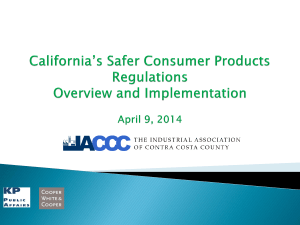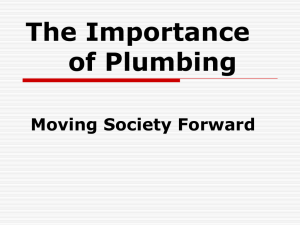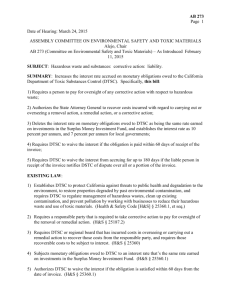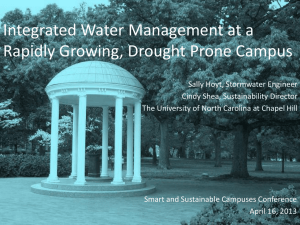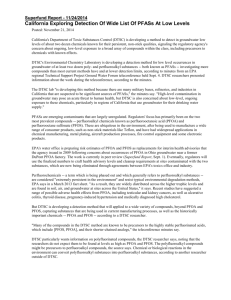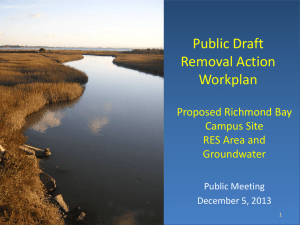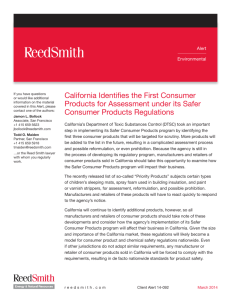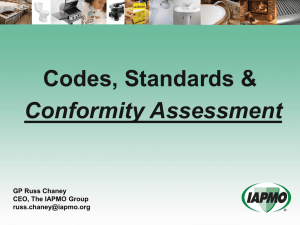Lead in Plumbing
advertisement
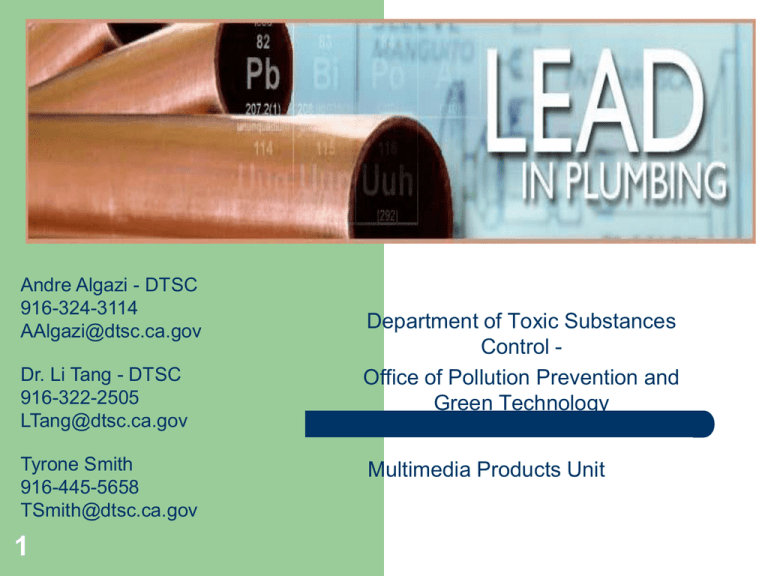
Andre Algazi - DTSC 916-324-3114 AAlgazi@dtsc.ca.gov Dr. Li Tang - DTSC 916-322-2505 LTang@dtsc.ca.gov Tyrone Smith 916-445-5658 TSmith@dtsc.ca.gov 1 Department of Toxic Substances Control Office of Pollution Prevention and Green Technology Multimedia Products Unit Today’s Topics 2 Goals of AB 1953 Testing and Monitoring Results Regulatory Authorities NSF Standards and 3rd Party Certification Future Directions - National Standards Regulatory Background "Lead free," as defined in the SDWA, means that the maximum allowed concentration is: 3 0.2 percent in solder and flux; 8.0 percent in pipes and pipe fittings; 4.0 percent lead by dry weight in plumbing fittings and fixtures. Regulatory Background On January 1, 2010, California law (HSC section 116875) further reduced "lead free" to mean that the maximum allowed lead content is: 4 0.2 % lead in solder and flux; 0.25 % lead in wetted surfaces of pipes, pipe fittings, plumbing fittings and fixtures, as determined by a weighted average. Regulatory Background The new California law further prohibits: 5 Any person from using any pipe, pipe or plumbing fitting or fixture, solder, or flux that is not "lead free" in the installation or repair of any public water system or any plumbing in a facility providing water for human consumption, except when necessary for repair of leaded joints of cast iron pipes; Any person from introducing into commerce any pipe, pipe or plumbing fitting, or fixture that is not "lead free," except for a pipe that is used in manufacturing or industrial processing; Any person engaged in the business of selling plumbing supplies, except manufacturers, from selling solder or flux in the business that is not "lead free;" Regulatory Authorities State – – – Local – – – 6 Department of Toxic Substances Control HSC §25214.4.3 California Department of Public Health HSC §116875 CA Attorney General’s Office City/County Environmental Health Department Local Building Department City Attorney/County District Attorney Regulatory Authorities Con’t While DTSC is required to test and evaluate compliance to the lead free standards, enforcement authority of the lead free standard was not given to DTSC. Regarding the DPH Drinking Water Program (Drinking Water Program), if the products or components are considered part of a public water system, they are regulated through the Drinking Water Program requirements. 7 DTSC's Role in Implementing Low Lead in Plumbing Law Role as Auditor Testing Protocol Annual Sampling and Testing – Web Posting and Reporting Coordination and Outreach http://www.dtsc.ca.gov/PollutionPrevention/LeadInPlumbing.cfm 8 8 HSC § 25214.4.3 DTSC is required to: 1) annually select, to the extent resources are available, up to 75 drinking water faucets and other fittings and fixtures for testing and evaluation to determine compliance with the lead free standards in Health and Safety Code section 116875, 2) post the test results on DTSC’s internet web site, and 3) transmit the test results in an annual report to the California Department of Public Health (DPH). 9 Components and Wetted Surface Areas 10 2010 Lead in Plumbing Annual Report Posted on DTSC web site http://www.dtsc.ca.gov/PollutionPreventio n/LeadInPlumbing.cfm 11 Sampling from 1 January 2010 thru 31 December 2010 44 individual plumbing products collected and tested AB 1953 Sampling Results 12 AB 1953 Result by Product Types 13 Reduction of Lead in Drinking Water ActP.L. 111-380 (S. 3874) Amends SDWA Section 1417 – Prohibition on Use and Introduction into Commerce of Lead Pipes, Solder and Flux – – – – – 14 Changes the definition of “lead-free” by reducing lead content from 8% to a weighted average of not more than 0.25% in the wetted surface material (primarily affects brass/bronze) Modifies the applicability of the prohibitions by creating exemptions Eliminated provision that required certain products to comply with “voluntary” standards for lead leaching Establishes statutory requirement for calculating lead content Effective 36 months from signature – January 4, 2014 Lead and Copper Rule - Long Term Revision (LTR) 15 revise the regulations to include the new SDWA definition of lead free plumbing materials in the regulations EPA also intends to clarify how best to distinguish plumbing materials that are exempt from the requirements address third-party certification defining the extent of the repair use prohibition in the act. Lead and Copper Rule – LTR con’t 16 One option could be that unless products are used exclusively for non-potable purposes, they would have to meet the “lead-free” requirements. Another option is that both potable and nonpotable versions could be made, but only if the non-potable products are clearly labeled as not for potable applications New Lead Free Exemptions –1417(a)(4)(A) One exemption is for “pipes, pipe fittings, plumbing fittings, or fixtures, including backflow preventers, that are used exclusively for nonpotable services, such as manufacturing, industrial processing, irrigation, outdoor watering, or any other uses where the water is not anticipated to be used for human consumption;” 17 New Lead Free Exemptions 1417(a)(4)(B) Another exemption is for “toilets, bidets, urinals, fill valves, flushometer valves, tub fillers, shower valves, service saddles, or water distribution main gate valves that are 2 inches in diameter or larger. 18 Any item covered by either of the two exemptions can have any amount of lead. Issue #1: Demonstrating that Products are Lead Free Require manufacturers to have products certified by a qualified independent third party – 19 EPA assisted in the development of NSF/ANSI Standard 372 which uses the same calculation as required under new SDWA lead free definition Manufacturer certification with publicly available documentation of their calculations/tests Issue #2: Scope of the Exemptions 20 1417(a)(4)(A) Exemption –This exemption from the lead free requirements is for products that “are used exclusively for non-potable services”. To qualify for the exemption, must the product be physically incapable of use in potable services or could it be physically capable of use in potable services, but labeled as illegal for use in potable services? Issue #2: Scope of the Exemptions 21 Potential Approaches –Allow dual product lines (potable and non-potable products that are interchangeable) if the non-potable version of the product is labeled as not for potable purposes –All products that are interchangeable with a potable counterpart must meet the new lead content limit because it is not “used exclusively for non-potable services”. Issue #2a: Identifying Non-Potable Products if Dual Product Lines Allowed 22 If dual product lines are allowed, what kind of label should be used? Require labeling of package Require labeling of product Require labeling of package and product Issue #3: Identifying “Lead Free” Products • Labeling could help distinguish between back inventory that does not meet 0.25% lead content requirement and products that do meet the 0.25% lead content requirement • Approaches ? -Require independent third-party certification against NSF/ANSI Standard 372, which includes certifier’s mark -Require manufacturers to label products that meet 0.25% lead content if not done via third-party certification -Do not require labeling of lead content , rely on labeling of non-potable products or prohibit interchangeable non-potable products 23 Issue #4: Calculation of Lead Content 24 Lead content at the surface of the product is used Lead content of the alloy used to produce the wetted component is used and not just the lead at the surface layer NSF/ANSI 372 – 2011 NSF/ANSI 61 establishes limits for the amount of lead that may migrate into drinking water from the water contact materials within a drinking water contact product NSF/ANSI 372 establishes a limit on the amount of lead that may be contained within the water contact materials in a drinking water contact product. 25 Lead Content Verification Testing Lead content verification testing shall at a minimum include screening of the following: – – 26 Materials with lead content specifications greater than zero. Any materials, including coatings and their substrates, with wetted surfaces areas in excess of 10% of the wetted surface area of the product. Lead content screening Screening may be used to check the lead content in the following cases, but not limited to: – – – 27 Screening of components where no lead is expected (e.g. certain plastics, elastomers, coatings); Screening of components where lead is expected for comparison to material specification information; and Initial screening of components to identify and prioritize items for further testing. Issue #5: Repairing and Returning Products to Service 28 Potential Approaches Entire unit would need to meet 0.25% lead content Only components being replaced would need to meet the 0.25% lead content Approaches assume that all component parts being sold separately meet the 0.25% lead content Resources 29 DTSC’s lead in plumbing page – http://www.dtsc.ca.gov/PollutionPrevention/LeadInPlumbing.cfm NSF Low Lead Plumbing Products Guide – http://www.nsf.org/business/mechanical_plumbing/annexg.asp U.S EPA Commonly Asked Questions: Section 1417 of the Safe Drinking Water Act and the NSF Standard | Drinking Water Standards | US EPA – http://water.epa.gov/scitech/drinkingwater/dws/plumbing.cfm California Department of Public Health – Drinking Water Program's regulation of public water systems: AB1953DWP@cdph.ca.gov. Future Questions Call or e-mail OPPGT,Multimedia Products Unit Tyrone Smith (916) 445-5658 Leadinplumbing@dtsc.ca.gov 30 Contacts 31 For Lead and Copper Rule – LTR Upcoming Guidelines and Comments please contact: Lameka Smith, Standards and Risk Management Division, OGWDW, U.S. Environmental Protection Agency; by telephone (202) 564-1629 or email smith.lameka@epa.govmailto:
